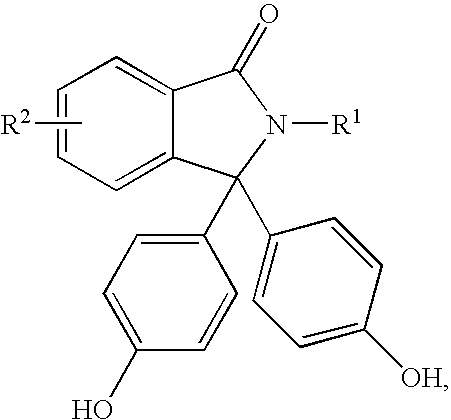Methods for producing and purifying 2-hydrocarbyl-3,3-bis(4-hydroxyaryl)phthalimidine monomers and polycarbonates derived therefrom
a technology of phthalimidine monomers and polycarbonates, which is applied in the field of producing and purifying 2hydrocarbyl3, 3bis (4hydroxyaryl) phthalimidine monomers, and polycarbonates, can solve the problems of increased brittleness, para-pppbp having an unacceptable purity for use as monomers or comonomers, and low average molecular weight polycarbonates
- Summary
- Abstract
- Description
- Claims
- Application Information
AI Technical Summary
Benefits of technology
Problems solved by technology
Method used
Image
Examples
example 1
[0119]This Example describes the preparation of para,para-PPPBP containing less than or equal to about 1,000 parts per million of ortho, para-PPPBP isomer impurity.
[0120]Phenolphthalein (31.8 grams), aniline (65 milliliters), and concentrated hydrochloric acid (20.5 milliliters) were taken in a reaction flask fitted with a Dean Stark condenser. The reaction mass was heated to an internal temperature of 155° C.-165° C. Water was collected during the course of the reaction. After being heated at this temperature for 14-15 hours, the reaction mixture was poured into a mixture of hydrochloric acid and water. The crude product, which precipitated, was collected by filtration and dissolved in an aqueous sodium hydroxide solution containing activated charcoal. After being stirred for about 30 minutes, the mixture was then filtered to remove the charcoal. The charcoal treatment step was repeated once more, and the resulting filtrate was treated with concentrated hydrochloric acid to precipi...
example 2
[0121]This Example describes the general melt transesterification method used for preparing polycarbonate copolymers using 47 weight percent of diphenyl carbonate and 53 weight percent of a monomer mixture consisting of 75 weight percent of BPA and 25 weight percent of the purified para,para-PPPBP prepared in accordance with Example 1.
[0122]A glass polymerization reactor was passivated by soaking the reactor in a bath containing 1 molar aqueous hydrochloric acid solution. After 24 hours, the reactor was thoroughly rinsed with demineralized water, and finally, with deionized water to ensure that all traces of acid and other contaminants were removed. The reactor was then thoroughly dried and charged with the appropriate amounts of the purified para,para-PPPBP monomer or a monomer mixture comprising the purified para,para-PPPBP and diphenyl carbonate monomers. The reactor was then mounted in a polymerization assembly and checked to ensure that no leaks were present. The catalyst solut...
example 3
[0123]This Example describes the melt transesterification method used for preparing polycarbonate copolymer using 55 weight percent of bismethylsalicyl carbonate and 45 weight percent of a monomer mixture comprising 75 weight percent of BPA and 25 weight percent of purified para,para-PPPBP (prepared as described in Example 1). The polymerization runs were carried using.
[0124]The same procedure as described above was used to charge the necessary reaction ingredients into the reactor. However, after the heating step to fully melt the monomer, the reaction mixture was heated to a temperature of about 210° C. at atmospheric pressure (about 910 millibar). After stirring the reaction mass at this condition for about 10 minutes, the pressure was reduced to about 100 millibars, and maintained at this condition for about 15 minutes. Next, the reaction mixture was heated to a temperature of about 310° C. while bring the pressure down to less than or equal to about 1 millibar. After being stir...
PUM
| Property | Measurement | Unit |
|---|---|---|
| yellowness index | aaaaa | aaaaa |
| yellowness index | aaaaa | aaaaa |
| weight average molecular weight | aaaaa | aaaaa |
Abstract
Description
Claims
Application Information
 Login to View More
Login to View More - R&D
- Intellectual Property
- Life Sciences
- Materials
- Tech Scout
- Unparalleled Data Quality
- Higher Quality Content
- 60% Fewer Hallucinations
Browse by: Latest US Patents, China's latest patents, Technical Efficacy Thesaurus, Application Domain, Technology Topic, Popular Technical Reports.
© 2025 PatSnap. All rights reserved.Legal|Privacy policy|Modern Slavery Act Transparency Statement|Sitemap|About US| Contact US: help@patsnap.com



